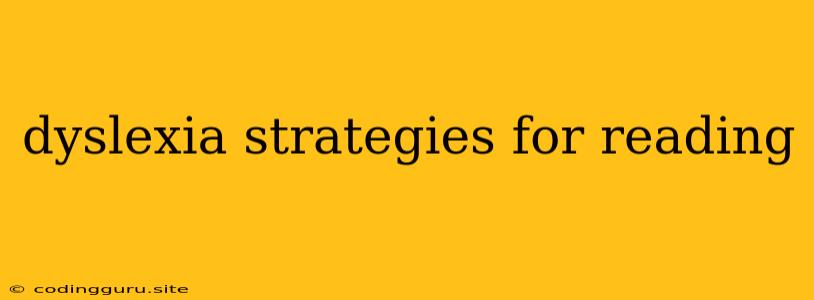Navigating the World of Words: Dyslexia Strategies for Reading
Living with dyslexia can present unique challenges, especially when it comes to reading. The journey to fluency and comprehension can feel like climbing a mountain, but with the right strategies, it's a climb you can conquer. This article explores practical and effective ways to make reading more accessible for individuals with dyslexia.
Understanding Dyslexia: A Key to Success
Dyslexia, a learning disability that affects reading, isn't about intelligence or effort. It's about the brain processing information differently. The most common challenges include:
- Decoding: Struggling to sound out words and connect letters to sounds.
- Phonics: Difficulty understanding how sounds and letters relate.
- Fluency: Reading slowly and haltingly, impacting comprehension.
- Comprehension: Difficulty grasping the meaning of what is read.
Understanding these challenges is the first step towards developing effective dyslexia strategies for reading.
Dyslexia Strategies for Reading: A Toolkit for Success
1. Multisensory Learning:
- Embrace Visuals: Visual aids like color-coded charts, flashcards, and graphic organizers can help make reading more engaging and easier to understand.
- Auditory Support: Audiobooks, recordings of text, and reading aloud with a tutor or teacher can provide valuable support.
- Kinesthetic Involvement: Engage the body through activities like tracing words, using finger puppets to act out stories, or building models to represent concepts.
2. Focus on Strengths:
- Highlight Areas of Strength: Identify the learner's strengths, such as visual memory, creativity, or verbal skills.
- Build Confidence: Celebrate small victories and focus on progress, not perfection. Encourage the learner to see themselves as a capable reader.
- Adapt and Modify: Tailor reading materials and assignments to the learner's specific strengths and needs.
3. Strategies for Decoding:
- Phonics Instruction: Focus on systematic and explicit phonics instruction that emphasizes sound-letter relationships.
- Word Walls: Create visual reference points with frequently used words, helping learners connect words to their sounds.
- Chunking Words: Break down complex words into smaller, manageable chunks to improve decoding.
4. Strategies for Fluency:
- Repeated Reading: Practice reading aloud the same text multiple times to improve speed and accuracy.
- Choral Reading: Read alongside a tutor, teacher, or peer, helping to build fluency and rhythm.
- Technology Tools: Use text-to-speech software or digital readers that highlight words as they are read.
5. Strategies for Comprehension:
- Visual Representations: Encourage the use of graphic organizers, diagrams, or mind maps to visually represent the information being read.
- Active Reading Strategies: Teach learners how to use question-answer-relationship (QAR), summarizing, and predicting skills to enhance comprehension.
- Discussion and Collaboration: Create opportunities for learners to discuss what they have read with peers, teachers, or parents, fostering deeper understanding.
Dyslexia Strategies for Reading: Beyond the Classroom
1. Supportive Environment:
- Create a Positive Atmosphere: Emphasize a growth mindset and celebrate effort over perfection.
- Reduce Stress and Anxiety: Ensure a calm and supportive learning environment.
- Encourage Open Communication: Establish open channels for communication between the learner, teachers, and parents.
2. Technology and Resources:
- Text-to-Speech Software: Utilize assistive technology to make reading more accessible.
- Digital Dictionaries: Provide readily available access to definitions and pronunciation guides.
- Online Learning Platforms: Explore online resources and programs specifically designed for learners with dyslexia.
3. Advocate for Support:
- Communicate with Educators: Keep teachers informed about the learner's needs and any specific dyslexia strategies that are working.
- Seek Professional Help: Consult with specialists like reading specialists, occupational therapists, or psychologists for personalized interventions.
- Join Support Groups: Connect with other families facing similar challenges, sharing experiences and learning from each other.
Dyslexia Strategies for Reading: A Lifelong Journey
Reading with dyslexia is a journey, not a destination. It requires patience, persistence, and a commitment to providing the right support. By implementing these strategies, we can empower individuals with dyslexia to unlock their full potential and embrace the joy of reading.
Remember: Every learner is unique, and the most effective dyslexia strategies for reading will vary based on individual needs and learning styles. Open communication, a supportive environment, and a willingness to adapt are key to success.
